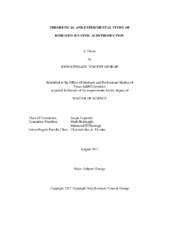| dc.description.abstract | Biomass based succinic acid is gaining increasing interest as a potential platform chemical for replacing a large petroleum-based bulk chemical market. Biomass as a renewable resource has proved the economic and sustainable potential to produce succinic acid by fermentation method. Biobased succinic acid has yet faced with the challenge of becoming competitive with petrochemical method because of its higher production cost.
To lower the production cost, extensive research efforts have been undertaken in upstream technology that involves strain development via metabolic engineering, and downstream technology that aims to improve efficiency of purification method. Many research studies have focused on either one of two technological areas, with little interest on interaction between them.
This present work integrates the processing steps from upstream and downstream technologies using a systematic approach and presents an optimal production pathway from a large number of possible process configurations. The development of such a process pathway involves selection of bioproducts, feedstock, pre-treatment technology, microorganism and product separation method. Performance criteria such as titre, rate, yield and minimum production cost, express the optimality of production pathway.
Optimization study indicates that succinic acid seems to be the most promising bioproduct among all other bioproducts. Corn stover is the suitable feedstock to produce succinic acid.
Based on the findings from optimization study, experimental work was performed with an aim of achieving better performance criteria than it is reported in literature. This work selected corn stover as feedstock, and a bacterium called, Basfia succiniciproducens for converting corn stover-derived glucose into succinic acid. To date, no deliberate experiment has been done on this bacterium to improve succinic acid production, despite its promising features. Highest succinic acid yield of 18 g/100g total sugar (glucose plus xylose) was observed in this experiment. Genetically modified strain of the bacterium reported a much higher yield of 71 gm succinic acid/ 100gm of glucose. | en |


